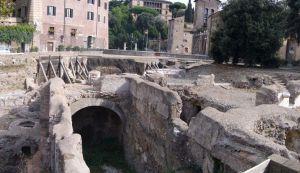Rome's main ghetto was declared in 1555, when the pope decided to segregate Jews from Christians - and so was a second ghetto, that vanished from memory.
Micol Debash
Source - http://www.haaretz.com/archaeology/1.629346

Excavation of medieval houses in the Ghettarello area of 16th century Rome, at the Piazza di Monte Savello.Photo by Lalupa, Wikimedia Commons
A forgotten Jewish ghetto dating from the 16th century has been found in Rome - by an archivist, Giancarlo Spizzichino, who spent almost a year digging through dusty folders for a study on the city's Jewish community.
In fact the capital of the Holy Roman Empire had not one Jewish ghetto, as had been thought, but two. This second, rediscovered last year, was known as the Ghettarello.
The main Ghetto of Rome was established on July 14, 1555 when Pope Paul IV issued his Cum nimis absurdum papal bull, imposing harsh religious and economic restrictions on the Jews.
In his bull, Pope Paul IV ordered Jews to be separated from the rest of the population, "since it is completely senseless and inappropriate to be in a situation where Christian piety allows the Jews access to our society," he wrote.
Centuries later, based on a study of archival material in 2013, it turned out that both the main ghetto and the smaller Ghettarello were established that year.

Excavating the Ghettarello, Mount of Savello, 16th-century Rome. Photo by Lalupa, Wikimedia Commons
According to the papal census of the time, there were 4,060 Jews living in Rome, of whom 180 families – many of them poor - lived and worked in the Ghettarello, as did some Catholics. The Ghettarello also had a synagogue, Porta Leone.
Spizzichino found the story of the Ghettarello, also known as the Macelletto, in a folder titled "Miscellanea".
Based on a 16th century map by an Italian architect of the time, Giambattista Nolli , the long-forgotten ghetto was located on the Mount of Savello, next to the Church of Saint Gregorio alla Pietà. It was not far from the Great Synagogue of Rome, the city's main synagogue today.
The two Jewish ghettos in Rome were subject to the same rules. They were required to open with the dawn and close with the sunset. Both ghettos had several Jewish-owned wheat storehouses, some of which were used to bake matza for Passover.
Defiant in worship
According to the Pope's bull, Jews were only allowed to have one synagogue. Yet the 16th century Roman Jewry had six, of which five were hidden in the so-called "Cinque Scole". That was a single building but it was divided into five smaller synagogues, each with its own unique traditions.
The sixth, the Porta Leone Synagogue, was located in the Ghettarello. It was a very tiny, and was to be active for 150 years. Perhaps throughout that time the church kept a blind eye to its operations, but ultimately was closed, based on the papal edict allowing the Roman Jews just one house of worship.
In 1620, the Papal State decided to close the Ghettarello itself, even though the Roman Jewish community was paying rent for its buildings. The ghetto was saved when the Universitas Hebreorum Urbis, the predecessor to the Jewish community of Rome, paid 1,000 scudi (equivalent to about $6,000) to the Papal State for the right to keep renting the buildings.
Ironically, the Papal State would use that money to finance the House of Catechumens, where forced conversions of Jews into Catholics took place.
Sanctuary from the plague
Paying that "ransom" for the Ghettarello and keeping it open may have helped save some Jews from the plague of 1656-1657. The crowded main ghetto suffered badly from the disease, but not so the residents of the smaller Ghettarello – to which Jews free of the disease fled to escape infection.
After the ransom was paid, the Ghettarello would stay open for another 80 years. Then, in 1730, with the election of Pope Clement XII, the Papal State issued a new order evicting the Jews from the Ghettarello.
A long legal battle would ensue between the Papal State and representatives of the Jewish community of Rome. Some Catholics who lived in the area testified in favor of the Jews. But in 1735 the Ghettarello was closed down and the Jewish families living and working there had to move.
The Jewish community then asked to enlarge the Cinque Scole Synagogue, arguing that the building could not contain all Jewish worshippers, who numbered 1,017. The Papal State however demonstrated that the Cinque Scole could hold up to 4,060 people. The upshot was that Roman Jewry lost the Ghettarello while the main ghetto stayed as it was, and over time, even the memory of it was lost.
The Papal State had a number of reasons to close the Ghettarello. For one, it was under financial stress, which could be partially alleviated by selling the ghetto buildings. Also, the Pope needed to fight against the tendencies of the Enlightenment, where an appeal to reason was favored over faith. Anti-Jewish regulation and legislation were starting to be repealed: the Pope, according to Spizzichino, felt threatened by these changes and for his part, became even more severe.
And thus the Papal State closed the Ghettarello with its synagogue, which had operated for 150 years under the nose of the church.
“Closing the Ghettarello was one of the many acts of the Papal State to put pressure on the Jews in order to force them to give up on their religion and identity,” explained Spizzichino (since deceased).
The Ghettarello ruins are still visible today. Excavations have uncovered two streets covered of Rome's 16th century typical kind of pavement named the sampietrini, an oven likely used to bake matza, the gate to a courtyard, the foundation of a palace, a Roman column and a drinking trough from the stables. The entrance to the Ghettarello remains buried, under a small fenced garden. It will probably stay that way, at least unless more funds are found for digging.